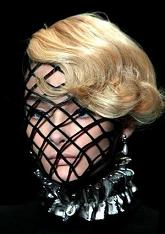 The most recent Paris Fashion Week has sparked controversy among fashion critics and feminists alike, not so much over what the models were wearing on their bodies, but instead, what they were wearing on–or over–their heads.
The most recent Paris Fashion Week has sparked controversy among fashion critics and feminists alike, not so much over what the models were wearing on their bodies, but instead, what they were wearing on–or over–their heads.
The burqa (the most extreme style of covering worn by Muslim women) and the hijab (veil) have apparently been inspiring couture designers to cover and even confine women’s heads, faces, and even entire bodies as they make their way down the catwalk. Some of these head coverings have prompted audiences to wonder if the models are even able to see.
Robin Givhan of “The Washington Post” reported about the show causing the most controversy of all that:
At the presentation of the presciently named Undercover collection Monday evening, models stepped into the spotlight with their heads wrapped tightly, unforgivingly and, one must admit, artfully in fabric with all the translucence of a pillowcase. Could the models in Undercover even see where they were walking? Several of them wandered just a bit off-track, bumping shoulders and even meandering into the audience seating area until redirected by a handler. Each model’s entire head was bound in fabric–black, brown or white–with only tiny pinholes for air. The fabric was knotted in back–or at what one assumed to be the back of the head–in the manner of a tight chignon. Sometimes the fabric was pierced with silver rings and charms, like those worn by a tribal warrior or some disaffected teen aspiring to lead a punk band.
The affect of this display on the audience watching?
There is a lot of anger… because the collection’s Japanese designer, Jun Takahashi– a man!–has decided that part of his aesthetic involved putting a woman’s head into, essentially, a sack. Under the best of circumstances, a model is little more than a vehicle for someone else’s creative expression. The most in-demand models are not the ones bursting with their own personality but rather those who allow themselves to be possessed by someone else’s. With their identical matchstick bodies, only their faces distinguish them as individuals. In one stylistic flourish, Takahashi took that away. With their heads covered, his women are silent and powerless. They look like victims: hostages, prisoners awaiting execution, the vulnerable.
The possibility of the new “burqa-chic” ever hitting the sidewalk even on the style-conscious streets of Paris and New York is highly unlikely. As everyone knows, couture design rarely makes it’s way into the real lives and onto the real bodies of people not regularly walking down the fashion runways. Regardless, while reserving judgment about the various traditional coverings for women within the Muslim faith, I find the explicitly violent edge and associations with female bondage among male desires of late extremely disturbing. What exactly are they trying to say to women?


